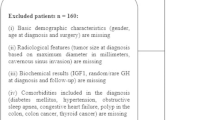Abstract
Untreated acromegaly is associated with a twofold to fourfold increased mortality risk compared to the population. Recently, new therapeutic modalities have been developed and may contribute to an improvement in treatment outcomes in patients with acromegaly. In the current study we determined the clinical features and recent therapeutic outcomes in patients with acromegaly. The initial symptoms, selected therapeutic modalities, and outcomes in 125 patients with acromegaly (M/F, 49/76, 19–86 years) who were admitted to our institution between 2001 and 2010 were analyzed using medical charts. The basal GH levels and IGF-I SD scores in the patients ranged from 0.17 to 90.21 μg/L and 1.9–13.6, respectively. Acral enlargement (face, hands, and feet) without overt complications was essential to the diagnosis in 49 % of the patients. In these cases, it required 5 years to establish the diagnosis of acromegaly after symptom onset. Twenty (16 %) and 13 (10 %) patients had diabetes mellitus and hypertension 6 years prior to the diagnosis of acromegaly, respectively. In 35 patients with microadenomas, the rate of controlled cases following transsphenoidal surgery was 93 %. In 90 patients with macroadenomas, the remission rate was 79 % with multidisciplinary treatment. In cases in which the tumor extended beyond the lateral tangent of the internal carotid artery (Knosp grade ≥3), the remission rate was 33–56 %. Improvements in surgical techniques and medical therapies may contribute to increased rates of controlled cases in patients with acromegaly, although advanced lateral extension of the tumor remains a critical determinant of the therapeutic outcome.




Similar content being viewed by others
References
Katznelson L (2005) Diagnosis and treatment of acromegaly. Growth Horm IGF Res 15(Suppl A):S31–S35
Freda P (2003) How effective are current therapies for acromegaly? Growth Horm IGF Res 13(Suppl A):S144–S151
Jezkova J, Marek J, Hana V, Weiss V, Vladyka V, Lisak R, Vymazal J, Pecen L (2006) Gamma knife radiosurgery for acromegaly–long-term experience. Clin Endocrinol (Oxf) 64(5):588–595
Melmed S, Colao A, Barkan A, Molitch M, Grossman A, Kleinberg D, Clemmons D, Chanson P, Laws E, Schlechte J, Vance M, Ho K, Giustina A (2009) Guidelines for acromegaly management: an update. J Clin Endocrinol Metab 94(5):1509–1517
Knosp E, Steiner E, Kitz K, Matula C (1993) Pituitary adenomas with invasion of the cavernous sinus space: a magnetic resonance imaging classification compared with surgical findings. Neurosurgery 33(4):610–617; discussion 617–618
Tanaka T, Tachibana K, Shimatsu A, Katsumata N, Tsushima T, Hizuka N, Fujieda K, Yokoya S, Irie M (2005) A nationwide attempt to standardize growth hormone assays. Horm Res 64(Suppl 2):6–11
Shimatsu A, Chihara K, Hizuka N, Teramoto A, Tanaka T, Tatsumi K, Tachibana K, Katsumata N, Yokoya S, Fujieda K (2007) Reference intervals of serum insulin-like growth factor-I in adult Japanese population: calculated with LMS methods. Hormon Rinsho (Clin Endocrinol) 55:393–399 (in Japanease)
Jadresic A, Banks LM, Child DF, Diamant L, Doyle FH, Fraser TR, Joplin GF (1982) The acromegaly syndrome. Relation between clinical features, growth hormone values and radiological characteristics of the pituitary tumours. Q J Med 51(202):189–204
Arosio M, Reimondo G, Malchiodi E, Berchialla P, Borraccino A, De Marinis L, Pivonello R, Grottoli S, Losa M, Cannavo S, Minuto F, Montini M, Bondanelli M, Demenis E, Martini C, Angeletti G, Velardo A, Peri A, Faustini-Fustini M, Tita P, Pigliaru F, Borretta G, Scaroni C, Bazzoni N, Bianchi A, Appetecchia M, Cavagnini F, Lombardi G, Ghigo E, Beck-Peccoz P, Colao A, Terzolo M (2012) Predictors of morbidity and mortality in acromegaly, an Italian survey. Eur J Endocrinol 167:189–198
Giustina A, Barkan A, Casanueva F, Cavagnini F, Frohman L, Ho K, Veldhuis J, Wass J, Von Werder K, Melmed S (2000) Criteria for cure of acromegaly: a consensus statement. J Clin Endocrinol Metab 85(2):526–529
Ben-Shlomo A, Melmed S (2008) Acromegaly. Endocrinol Metab Clin North Am 37(1):101–122
Fukuda I, Hizuka N, Murakami Y, Itoh E, Yasumoto K, Sata A, Takano K (2001) Clinical features and therapeutic outcomes of 65 patients with acromegaly at Tokyo Women’s Medical University. Intern Med 40(10):987–992
Acknowledgments
This work was supported in part by a Grant-in-Aid for Scientific Research (Research on Hypothalamo-Hypophyseal Disorders) from the Ministry of Health, Labor, and Welfare of Japan.
Conflict of interest
The authors declare that they have no conflict of interest.
Ethical standards
This study complies with the current laws of Japan.
Author information
Authors and Affiliations
Corresponding author
Rights and permissions
About this article
Cite this article
Fukuda, I., Hizuka, N., Muraoka, T. et al. Clinical features and therapeutic outcomes of acromegaly during the recent 10 years in a single institution in Japan. Pituitary 17, 90–95 (2014). https://doi.org/10.1007/s11102-013-0472-6
Published:
Issue Date:
DOI: https://doi.org/10.1007/s11102-013-0472-6



